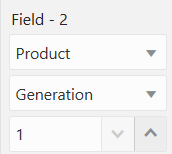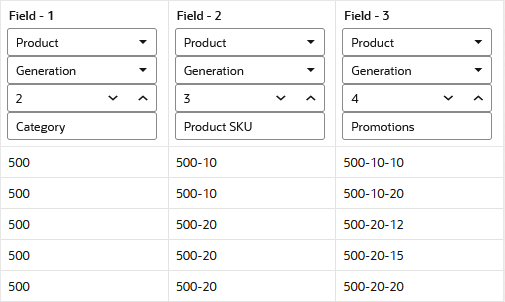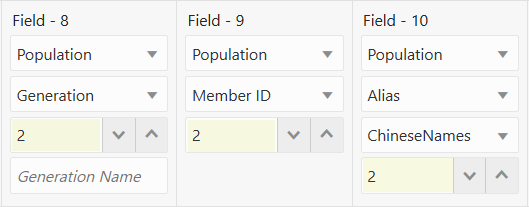Set Dimension Build Field Type Information
If you are not performing a dimension build, skip this topic.
When you set field types in the rule, you specify at least the following information:
-
The dimension to which the members of that column belong.
-
The type of field to expect in that column, such as a parent, child, generation, property, or alias. The field type depends on the data source and the build method used.

-
Additional information depending on the field type. For example, for a generation field type, you also specify the generation number of the members of that column.

Field Types and Valid Build Methods
When designing a dimension build rule, you assign types to the source data fields to help Essbase build the dimension correctly.
In the Essbase web interface, you assign the type below the dimension name:

The following table lists field types and valid build methods.
Table 12-1 Field Types and Valid Build Methods
| Field Type(1) | What the Field Contains | Valid Build Methods |
|---|---|---|
|
Alias |
An alias The alias value will not be assigned to the new member if Member update dimension build is set to Remove unspecified and the data source for a new member contains the alias value of a removed member. It will be assigned if you specify Reset Dimension. In a Regular rule, there must be a Generation or Level field with the same value, or, a preceding field must be a parent or child. In an Index-based rule, there must be a Generation or Level field with the same value, or, a preceding field must be a parent or child. |
Generation, level, and parent-child references |
|
Property |
A member property. In the source data, use the following codes to specify the property. Consolidation Operator
Data storage type
Time Balance
Two Pass Calculation
Skip Option
Expense Reporting
Hierarchy Type
|
Generation, level, and parent-child references |
|
Formula |
A formula |
|
|
Currency name |
(Block storage outlines only) A currency name |
|
|
Currency category |
(Block storage outlines only) A currency category |
|
|
UDA |
A UDA |
|
|
Attribute Dimension |
An attribute dimension. Available in Regular and Index-based rules. | |
|
Attribute parent |
In an attribute dimension, the name of the parent member of the attribute member in the subsequent field. Only needed if the outline is duplicate member enabled, and there are two attribute members of the same name. Only available for Regular rules. |
|
|
The name of a specific attribute dimension |
A member of the specified attribute dimension. This member is associated with a specified generation or level of the selected base dimension. |
|
|
Generation |
The name of a member in the specified generation |
Generation references |
|
Duplicate generation |
The name of a member with a shared member as a child. Only available for Regular rules. |
|
|
Duplicate generation alias |
The alias for the shared member. Only available for Regular rules. |
|
|
Level |
The name of a member in a level. Only available for Regular rules. |
Level references |
|
Duplicate level |
The name of a member with a shared member as a child. Only available for Regular rules. |
|
|
Duplicate level alias |
The alias for the shared member. Only available for Regular rules. |
|
|
Parent |
The name of a parent. |
Parent-child reference |
|
Child |
The name of a child. There must be a parent field somewhere preceding it. |
|
|
Priority in which the member is calculated ( 0 to 127 ) |
||
|
Unique identifier for a member, separate from its name. Only available for Index-based rules. When you build dimensions, all members (including shared members) have unique member IDs. If you migrate an existing outline using one of the Essbase migration tools, then member IDs are automatically assigned during migration. If you patch Essbase without migrating using one of the Essbase migration tools, then member IDs are assigned on the first successful edit of the outline after you apply the patch. |
||
|
Reference Member |
Supported only in Index-based rules, this type offers flexibility in modifying existing members. Use of this type requires the field to refer to an already-existing member. For a use case, see "Bonus Exercise" in Create New Dimension Build Rule |
Generation References |
|
Aggregate Level Usage |
Options for influencing default and query-based view selection on aggregate storage cubes.
|
|
| Format String | A format string, if your cube is enabled for typed measures. The format string lets you format the values of numeric typed measures so that they appear in queries as text, dates, or other predefined types. For example, using a text-based formatted value, you can display data cells as “High,” “Medium,” and “Low.” | |
| Prototype | The member ID (or unique name) of the prototype member for this shared member. This field is required for shared members in duplicate member outlines. If this value is not set, the members will be created as duplicate members instead of shared members. |
Footnote 1 Field types whose names begin with duplicate (such as duplicate generation and duplicate level alias), are not related to duplicate member names.
Parent-Child Build Method Example
The following is an example of a dimension build rule that uses the Parent-child build method. Field type of Parent must come first, followed by children.

Generation Build Method Example
The following is an example of a dimension build rule that uses the Generation build method. Generation 1 is the dimension itself, so the build rule starts with Generation 2. Generations must be in ascending order in the rule, as this is a regular (non-Index-based) rule.

Requirements for Assigning Field Types
Each build method has requirements for assigning field types.
Generation build method requirements for Regular (non-Index) dimension builds:
-
If generation numbers do not start at 2, the first member of the specified generation must exist in the outline.
-
Generation numbers must form a contiguous range. For example, if generation 3 and 5 exist, you must also define generation 4.
-
Place Duplicate Generation fields immediately after generation fields (these are applicable if you use shared members in a generation build method rule). Likewise, place Duplicate Generation Alias fields immidately after Duplicate Generation fields.

-
Group generation fields sequentially within a dimension. For example:
Product Generation 2, Product Generation 3, Product Generation 4.
-
Place attribute association fields after the base field with which they are associated, and specify the generation number of the associated base dimension member. For example:
Product Generation 2, Product Generation 3, Product Ounces 3
The generation number must correspond to the generation of the member in the outline for which the field provides values. For example, Product Generation 3 means that the values in the field are third-generation members of the Product dimension. The
2in Population Member ID 2, and Population Alias 2 shows that the values in the field are associated with the second-generation member of the Population dimension.
Note:
When using the generation build method to create a duplicate member dimension, the maximum number of generations is 20.
Level build method requirements:
-
Place Duplicate Level fields immediately after level fields (these are applicable if you use shared members in a level build method rule). Likewise, place Duplicate Level Alias fields immediately after Duplicate Level fields.
-
Each record must contain a level 0 member. If a level 0 member is repeated on a new record with a different parent, Essbase rejects the record unless you select the Allow Moves member property.
-
Group level fields sequentially within a dimension.
-
Place the fields for each roll-up in sequential order.
-
Use a single record to describe the primary and secondary roll-ups.
-
Place attribute association fields after the base field with which they are associated, and specify the level number of the associated base dimension member. For example:
Product Level 3, Product Ounces 3, Product Level 2
-
The level number must correspond to the level of the member in the outline for which the field provides values. For example, the 3 in Product Level 3 shows that the values in the field are level 3 members of the Product dimension. The
2in Population Alias 2 shows that the values in the field are associated with the second level of the Population dimension.
Parent-child build method requirements:
If field type is parent or child, enter 0 (zero) in the Number text box.
Attribute dimension name build method requirements:
The generation or level number must correspond to the generation or level of the associated base member in the outline. For example, the 3 in Product Ounces 3 shows that the values in the field are the members of the Ounces attribute dimension that are associated with the third-generation member of the Product dimension in the same source data record.
If necessary, move the fields to the required locations.